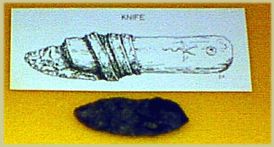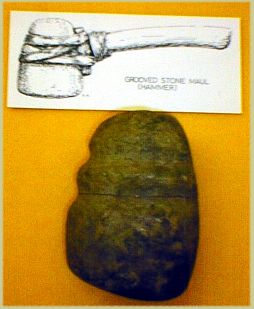 |
 |
|||||||||||||||||||
 |
||||||||||||||||||||
| Long before Europeans came to south-western Manitoba, nomadic tribes of aboriginal peoples passed through the area hunting the native animals and gathering foods. During the many years before the fur trade began, a series of different peoples inhabited Manitoba's south west. Little is known of the earliest peoples to live in this part of the continent, though more is rapidly being discovered at an archaeological dig near Lauder, Manitoba. More is known about the lifestyle of the more recent inhabitants of this area. | ||||||||||||||||||||
|
|
||||||||||||||||||||
 |
||||||||||||||||||||
| South-western Manitoba was home to nomadic hunters. Various tribes may have crossed through the area over the centuries but during the time just before the coming of the Europeans, the Cree were the dominant tribe in the area. |
||||||||||||||||||||
| Plains Indians lived off the herds of bison that roamed the prairie. The migration of the bison determined the lifestyle of the people; they could not live where there were no bison. | ||||||||||||||||||||
|
|
||||||||||||||||||||
| Little trade occurred between bands and, for the most part, a group had to produce all that it needed for itself. The bodies of the bison provided numerous important products. Leather and fur were used to make warm clothing, which would certainly have been necessary during the winters of the northern prairies. The bones of the bison were often used to make tools and the innards and sinews were used to make string to sew clothing and other items. | ||||||||||||||||||||
| Other tools were fashioned from rock. Arrow heads are very common relics today, showing that a large number of them must have been produced. Hunting weapons were important and it was necessary to make them out of stone in order to ensure the greatest possible success while on the hunt. |
 |
|||||||||||||||||||
| Stone was also used to create tools such as pestle and mortars and hide scrapers. Stone hammer heads are very commonly discovered relics, most likely because of their size and enduring shape. The hammers were used for all sorts of jobs such as crushing bones and chipping rocks for arrowheads. | ||||||||||||||||||||
| Dependence on the bison herds necessitated a nomadic existence on the open prairie. Nights were often spent without shelter at all. Shelter that was used was portable and would travel across the plains with the band or simply be built on the spot. The most common form of shelter was the tepee. The tepee could be disassembled, placed on a travois and pulled by dogs. | ||||||||||||||||||||
|
|
||||||||||||||||||||
| Though the simple lifestyle of the native people is sometimes portrayed as idyllic, life was often hard on the prairies. Times of shortage were not unusual. If the bison were dying or were at a low point in their population cycle, people would be forced to go hungry. Disease was also a problem, but not to the degree that it was in the crowded cities of Europe. | ||||||||||||||||||||
 |
Bands were collections of families that lived together for mutual protection and to enhance their ability to produce necessities. Labour was primarily divided along gender lines. Men would do the hunting while women would gather plants, create clothing, and care for the children. The line between genders was distinct but it may not have been as definite as it was in Europe at the time, as men would often spend their time making tools and caring for the children. Status was very important to the social structure. Men could gain status by acting bravely in combat or during a hunt, making wise decisions, or by gaining spiritual insight through “vision quests”. Status-based customs included the warrior societies and the tradition of coup. Coup involved the glorification of daring deeds in combat such as capturing enemies in battle, taking horses or guns from the opponent, or any other brave act. |
|||||||||||||||||||
|
|
||||||||||||||||||||
| Religion was very much based on nature and natural events. People believed that their lives were to be lived in harmony with the laws of nature and that the ways of their ancestors exemplified the proper lifestyle. Benefits could be gained through a “vision quest”. The supplicant would undergo a period of meditation and deprivation, at the end of which a vision would come to them and grant them wisdom and good fortune. Rituals played an important part in social and spiritual life. The Sun Dance was particularly important to northern Plains Indians. Bands would gather together for a period of days to dance, perform rituals, and erect a ceremonial lodge and dance post. This custom was outlawed by the Indian Act of 1885 but this ban was largely ignored. In 1951 the ban was dropped. The lifestyle of the aboriginals in Canada remained the same for centuries before the coming of the Europeans. When the French and British did come, vast changes were wrought in mere decades. |
||||||||||||||||||||
|
|
||||||||||||||||||||